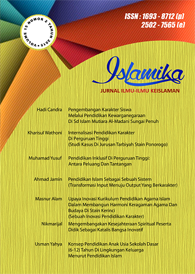AN ANALYSIS OF SWEAR-WORDS USED IN PONDOK TINGGI DIALECT OF KERINCI LANGUAGE
DOI:
https://doi.org/10.32939/islamika.v16i1.117Abstract
The expression of feelings can be delivered politely or impolitely. The impolite expression usually delivered by using swearwords or obscenities. In English, it is well-known as swear words. This study aimed to describe the types, meaning, and function of swear words spoken by natives in PondokTinggi, Sungai Penuh city. The research that was conducted inPondokTinggi, was included into descriptive study where the facts are what exactly found related to those words.From the results of the study, researchers found six different types of swear words that grouped by type that came from the name of the animal, excretion, parts and body functions, the plant names, name of the devil and sex. From this study, the meaning and the function of swear words based on the context of the situation of swear words seen from expression of native speakers.As this research can be still developed, it is advisable for other researchers to be able to produce advanced research for a deeper findings.
Downloads
References
Anwar, Joesnidar. Dkk. 1982. Morfologi Kata benda dan Kata Sifat Bahasa Kerinci. Padang: Department Pendidikan dan Kebudayaan.
Brown, Gillian and George Yule. 1983. Discourse Analysis. London; Cambridge University
Crane, L. Ben. 1981. An Introduction to Linguistics. Toronto; Little, Brown and Company
Christie, Christine. 2013. The relevance of taboo language: An analysis of the indexical values of swearwords. Journal of Pragmatics 58 (2013) 152--169
Crystal, David. 1991. The Cambridge Encyclopedia of Language. Cambridge; Cambridge University Press
EnsiklopediNasional Indonesia 3B. 1988. Jambi. Jakarta: PT. CiptaAdiPusaka
Fägersten, Kristy Beers.2012. Who’s Swearing Now? The Social Aspects of Conversational Swearing. Cambridge: Cambridge Scholars Publishing
Gay, L.R and Airisian, Peter. 2000. Educational Research: Competencies for Analysis and Application. Prentice Hall : New Jersey
Irmawati. 2001. An analysis of Swear-words of Betawi Language used by students at Wisma Batavia (Unpublished Thesis). Padang: Universitas Bung Hatta
Leech, Geofrey. 1983. Principle of Pragmatics. Singapore: Longman Singapore Publisher Ptc. Ltd
Mardalis. 1995. MetodePenelitian. Jakarta: BumuAksara
Moore, Andrew. 2000. Semantics-meanings, etymology and the lexicon. Web Address: http://www.shunsley.eril.net/armoore/lang/semantics.htm, retrieved on January 6th 2008.
Pinker, Steven. 2008. Freedom’s Curse. The Atlantic Monthly 302 : 28-29
Roza. 2001. An Analysis od Swear-words in Minangkabau Language. (Unpublished Thesis). Padang: Universitas Bung Hatta.
Stapleton, Karyn. 2010. Swearing in Miriam A. Locher, Sage & L. Graham (eds). Interpersonal Pragmatics (289-305). Berlin: Walter de Gruyter GmbH & Co.
Surakhmad, Winarno. 1980. PengantarMetodeIlmiah. Bandung: Torsito
Udin, Syamsuddin, et al. 1983. Struktur Sastra Lisan Kerinci. Padang. Departemen Pendidikan dan Kebudayaan.
Thefreedictionary.com.2016.definition of swearing. Web Address: http://www.the-freedictionary.com/swearing, retrieved on January 6th 2016.
Wardaugh, Ronald. 1986. An Introduction to Sociolinguistics. Massachussets: Blackwell Publishers Ltd.
----------------. 1972. Introduction to Linguistics. Michigan: Megraw-Hill, Inc
Yasin, Anas. 1991. GrammatikaKomunikatif: Sebuah Model (Unpublished S3 Dissertation). Malang: IKIP Malang.










